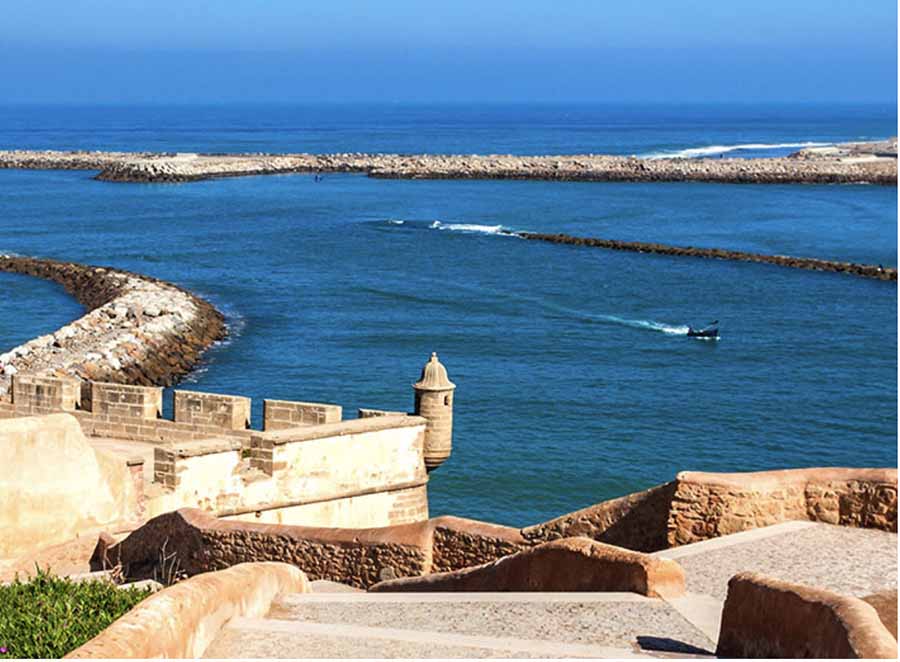
Ryanair has commenced a twice-weekly service from Dublin to Rabat, facilitating easy travel for tourists.
The fourth of Morocco’s imperial cities, Rabat presents an intriguing blend of a rich history and contemporary influences. Its peak occurred in the 12th century when the sultan utilized the kasbah (citadel) as a command centre for military campaigns against the Spanish.
This era saw the establishment of many of the city’s iconic landmarks. Rabat became a refuge for Muslims expelled from Spain in the early 17th century and has served as the capital since the French colonial period, combining Islamic and European influences in almost equal measure. The city features a higher concentration of European-style cafes than places of worship, allowing for a unique and relaxed atmosphere. Tourists can navigate the markets without facing aggressive sales tactics, as many locals are not involved in the tourism sector.
The most prominent site in the city is the Tour Hassan, a partially constructed minaret of a grand mosque initiated by Yacoub al-Mansour. Construction was halted in 1755 due to an earthquake. Adjacent to it is the Mausoleum of Mohammed V, dedicated to the current king’s father. The Kasbah des Oudaias, perched on a cliff with views of the Atlantic Ocean, includes a former palace that now serves as a museum of traditional art. Outside the city walls lie the remnants of ancient Sala, also known as Chella, which houses Morocco’s finest Archaeology Museum.
Between the central park, Jardins Triangle de Vue, and the main train station, you will find most of Rabat’s hotels and dining establishments. This area features a variety of cafes and bars offering beer, kebabs, pizza, olives, and ice cream. Mohammed V International Airport is located a short distance east of the city, with easy access to numerous shuttle buses.
About 80km awa is Casablanca, home to approximately three million residents, iMorocco’s largest city and the second most populous in Africa, following Cairo. It serves as the country’s economic hub, boasting the largest port as well as key commercial and industrial centres.
Originally a Berber settlement, it fell under Arab control in the 12th century, when the inhabitants took up piracy. Their success in this venture drew the attention of the Portuguese, who arrived in 1575, renovated the city, and fortified it, naming it “Casa Branca.”
After changing hands between the Spanish and French, Casablanca remained under French “protection” until 1956, when it became a Moroccan city once again. Today, it is a bustling metropolis surrounded by “bidonvilles,” or slum areas, housing the industrial workforce, which might not make it the most inviting destination for tourists. The main attractions include the nearby Ain Diab Beach resort, the port, the aquarium, the medina, and the central shopping district.
Things to do in Rabat
- Visit the Kasbah of the Oudayas. Wander through this 12th-century fortress at the mouth of the Bou Regreg River. Its narrow, blue-and-white streets are perfect for a leisurely stroll, and the Andalusian Gardens inside offer a peaceful retreat with stunning views of the Atlantic Ocean. Don’t miss the chance to sip mint tea at Café Maure while overlooking the river.
- Explore the Hassan Tower and Mausoleum of Mohammed V. These two landmarks sit side by side and are must-sees. The Hassan Tower, an unfinished 12th-century minaret, was meant to be the world’s tallest but remains a striking symbol of Rabat. Next to it, the Mausoleum of Mohammed V is a beautiful example of Moroccan architecture, housing the tombs of the late king and his sons. It’s open to all visitors, unlike many holy sites, making it a unique stop.
- Stroll Through the Medina of RabatRabat’s old town is less chaotic than those in Marrakech or Fez, offering a more relaxed way to experience Moroccan culture. Browse the souks for handmade crafts, spices, or leather goods, and enjoy the authentic vibe of this UNESCO World Heritage site. It’s a great spot to try local street food like fresh pastries or a tagine.
- Discover Chellah. This ancient site blends Roman ruins with a medieval Muslim necropolis, surrounded by gardens and stork nests. Located just outside the city center, it’s a quiet spot to explore history, from Phoenician times to the Merinid dynasty. Bring a camera—the scenery is picturesque, especially in spring.
- Relax at Rabat Beach or Temara Beach. Head to Rabat Beach for a laid-back coastal vibe or take a short 15-minute trip to Temara Beach for softer sands and gentle waves. Both are perfect for a walk, sunbathing, or even trying surfing if the conditions are right.
- Visit the Mohammed VI Museum of Modern and Contemporary Art. For a taste of Morocco’s artistic side, this museum showcases works by local and international artists. Housed in a renovated colonial building, it’s a refreshing contrast to the traditional sights and a great way to see Morocco’s modern creative scene.
- Walk Along the Bou Regreg River. The river separates Rabat from its sister city, Salé. Take a scenic walk along the waterfront, or cross over to Salé via the tram or a boat for a quick day trip. The views of the Kasbah and the Atlantic from here are unbeatable, especially at sunset.
- Experience the Royal Palace (Dar al-Makhzen). While you can’t go inside, the palace’s grand gates and gardens are worth a visit. It’s the official residence of King Mohammed VI and a symbol of Morocco’s monarchy, built in 1864. Snap some photos and admire the architecture from the outside.
- Enjoy the Andalusian Gardens. Tucked within the Kasbah of the Oudayas, these gardens were designed by the French in the 20th century. With orange trees, bougainvillea, and a tranquil atmosphere, it’s an ideal spot to unwind after exploring the city.
- Check Out Rabat Zoo. If you’re traveling with family or love wildlife, the Jardin Zoologique de Rabat is home to over 130 species, including Atlas lions descended from those once kept by the royal family. It’s a fun way to spend a few hours and see animals native to Morocco and Africa.



